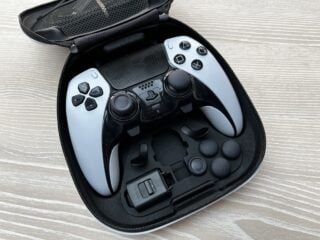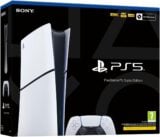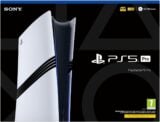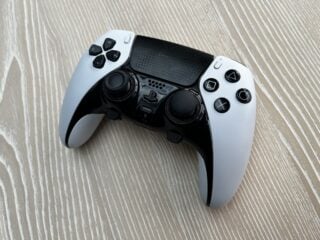@vgc_news We’ve got our hands on the new #PS5 Dualsense Edge 👀 #dualsensedge #ps5 #playstation5 #playstation5pro #playstation #dualsense #dualsensecontroller
♬ original sound - VGC
Review: DualSense Edge is the most premium PS5 controller yet
The $200 pad’s new features will appeal greatly to competitive players, if not everyone

Over seven years after Xbox introduced its premium Elite controller, PlayStation users have been crying out for their own official ‘pro’ alternative.
Sony dabbled in premium pad options with 2020’s DualShock back button attachment, but it arrived late in the PS4’s lifecycle and of course isn’t supported by PS5’s DualSense.
That’s meant that any PS5 owner looking for customisation and additional buttons has been forced to dive into the third-party market, with controllers such as Scuf Reflex Pro offering a premium (and pricey) alternative, but without many of Sony’s flagship features such as haptics and adaptive triggers.
Enter the DualSense Edge, a new $200 / £210 official controller that adds a lot of the features hardcore players have been asking for, such as the ability to add extra back buttons, tweak the deadzones of its sticks and triggers, along with the kind of slick backend integration only a first-party product can offer.
As you’d expect, the appearance and build quality of Edge is top-notch. The design is clearly strictly based on the original DualSense, which many would agree is an excellent pad in terms of feel, and holding the Edge in your hands feels incredibly similar to the PS5 controller.
The Edge’s aesthetic design changes are subtle but, in our opinion, an improvement; it weighs ever so slightly more in your hands (335g versus the original’s 281g), with new black accents along the rear, touch pad and face buttons.
The lower black ‘faceplate’ part of the controller now sports sleeker lines and a glossy finish, which initially concerned us for how smudgy it could get, but after five days of use still looks fairly presentable.
Elsewhere, the touchpad now features a slicker design with embossed PlayStation symbols, and the rear, and the L2 and R2 buttons are textured for better grip. The texture on the underside of the pad made up of thousands of tiny PlayStation symbols is also said to be grippier here, but we could barely tell the difference next to the original DualSense.

Depending on your taste (and how smudgy you get that glossy bottom finish), these are all welcome visual improvements to the DualSense. But combined, the actual feel is still remarkably similar to the original DualSense.
Sony has offered not to include the sort of rubberised grip offered by other premium controllers, including Elite, which we do feel could’ve improved its pad, and others will wish there were colour options beyond standard white.
That means the overiding appeal of DualSense Edge comes from what it adds, rather than what it improves from the original. And for competitive players, there are plenty of additions here that will appeal greatly. For everyone else, whether or not it’s worth the $130 upgrade will depend totally on whether you’re excited about back buttons and the ability to customise your dead zones.
Like the Xbox Elite, Edge comes in a nice hardshell case. In addition, there’s an extra-long USB-C wire included, four interchangeable sticks and four changeable back buttons. Sadly, there’s no charging station like Xbox’s offering, but otherwise it’s an equally premium package you’d expect for $200.
One unique addition compared to rivals is the connector housing, which is basically a special lock for stopping the USB-C wire from being pulled out of the controller mid-game. While this might not seem useful for home use, Sony’s EVO fighting game tournament only allows wired controllers and punishes disconnects, so there’s clear appeal for pro players.
The Edge’s included back buttons come in ‘level’ and ‘half dome’ varieties, but unlike the Xbox Elite and Scuf Reflex you can only attach two at a time. This didn’t bother us, as we always found four back buttons in addition to the existing triggers and bumpers to be a bit excessive in most cases.
The ‘half dome’ buttons are our personal favourite, as they allow you to rest your fingers more naturally on the controller and avoid having to place them permanently on top of the ‘levers’, which can result in accidental presses.
As anyone who’s ever used them will tell you, back buttons can be incredibly useful for making certain game functions available right at your fingertips, such as the roll or menu functions from Elden Ring, or jump and crouch in Apex Legends.
Meanwhile, the interchangeable stick ‘caps’ come in high and low varieties, with the former feeling more useful for fighting games and other genres requiring slightly slower, precise movement.
The most appealing thing about these caps, however, is the fact they come in a ‘PS3-style’ dome variety, which does feel better for certain styles of games. For example, we opted to keep the original DualSense left stick and swap out the right stick for the ‘PS3’ style, which made moving and aiming in FPS games feel slightly tighter.
Again, as you’d expect from a first-party product, interchanging these pieces is simple and satisfying. The back buttons are held in place by magnets inside little holes, while the stick domes simply snap on or off.
One feature that should prove welcome after excessive use is the ability to snap off the front faceplate using a rear release switch, after which you can remove the analog stick modules entirely. Sony is planning to sell replacement modules for $20 on its website, which should come as music to the ears of anyone concerned about stick drift.
“As anyone who’s ever used them will tell you, back buttons can be incredibly useful for making certain game functions available right at your fingertips, such as the roll or menu functions from Elden Ring, or jump and crouch in Apex Legends.”
In addition to these interchangeable physical elements, the other feature competitive players will greatly appreciate is the ability to adjust the travel distance of the Adaptive Triggers. This has been a contention point of pro players for many years, with many players desiring a quicker digital press to fire off in-game shots, rather than having to compress the entire trigger, which provides an obvious – if tiny – disadvantage in online games.
While the PlayStation 5 does allow players to remap which button serves which purpose, for example changing the fire button in a shooter to the much shallower shoulder buttons, DualSense Edge’s included switches solve the issue entirely, allowing users to individually set the travel distance of each trigger between high, medium and low settings.
That means, for example, players can set the right trigger to act like a digital bumper for shooting in an FPS game, while leaving the left trigger to act like the original DualSense for precise aim zooming. This can then be adjusted on the fly when switching to a racing game, where traditional triggers are more usual for adjusting speed.

Like everything on the DualSense Edge, the trigger sensitivity – as well as stick sensitivity and the function of all buttons including the new back levers – can be totally customised via the PS5 back-end, and if you prefer you can adjust their endzones without physically setting them to stop.
This is another way in which Edge feels premium compared to the competition on PS5, with rivals such as Scuf requiring users to hold down buttons and wait for blinking LEDs in order to customise their back buttons, while many other functions can’t be customised at all.
With Edge, users can use the new function buttons positioned underneath the analog sticks to quickly pull up a console UI offering various functions, like the ability to switch between different profiles by holding it down and pressing a corresponding face button (new LEDs on the touch pad even indicates which profile is active).
Three of these profiles are saved within the controller itself, which is useful for when taking your Edge to friends’ houses or tournaments, while up to 30 can be stored on the PS5 console itself.
“The biggest disappointment with Edge, as Sony wisely got ahead of with its own public disclosure, is that the battery within it is the same as in the original controller”
Holding function and the settings button takes users to the DualSense Edge menu, where you can edit profiles by customising any button on the controller, swapping the function of face buttons, stick presses, triggers and more.
Here users can also adjust haptic feedback, trigger endzones and even the sensitivity of the analog sitcks themselves. Sony has several built-in profiles for the sticks, such as ‘precise’, ‘quick’ and steady.
For Call of Duty, we set our right stick to ‘precise’, which made aiming long-range weapons feel just that little bit easier, and we had another profile set to ‘quick’, which we could easily switch to with a press of function & X for when using close-range SMGs.
The biggest disappointment with Edge, as Sony wisely got ahead of with its own public disclosure, is that the battery within it is the same as in the original controller – which already struggled to last more than six hours in some titles, without all the new buttons and functionality introduced here.

This means that, in Sony’s words, battery life is “moderately shorter” than the original DualSense. In our experience with Edge, it’s very comparable to the original DualSense, ranging from 6 – 10 hours depending on how many of its features (particularly haptics) the game you’re playing uses.
More hardware focussed publications will certainly share their own scientific breakdowns about how and when it lasts “moderately shorter”, but even so, the fact that it doesn’t improve at all on the already criticised operating time of the original pad is a disappointment, especially for the price.
PC support is also a bit barebones at launch, with Edge functioning exactly like DualSense does without the ability to customise it outside of a PS5 console, like Xbox Elite (though Sony has hinted this could be coming in the future).
At $200, DualSense Edge was never going to appeal to everyone. But for competitive players, the quality of its build, slick software integration and the huge amount of customisation options means it’s undoubtedly the most premium PS5 controller you can buy.
For everyone else, it’s far from essential, especially if you don’t play competitive games or desire customisation beyond what the original DualSense is capable of.
At $200, DualSense Edge was never going to appeal to everyone. But for competitive players, the quality of its build, slick software integration and huge amount of customisation options means it’s undoubtedly the most premium PS5 controller you can buy.
- The most premium PS5 controller available
- Hugely customisable
- Slick software integration
- Battery life hasn't been improved






















